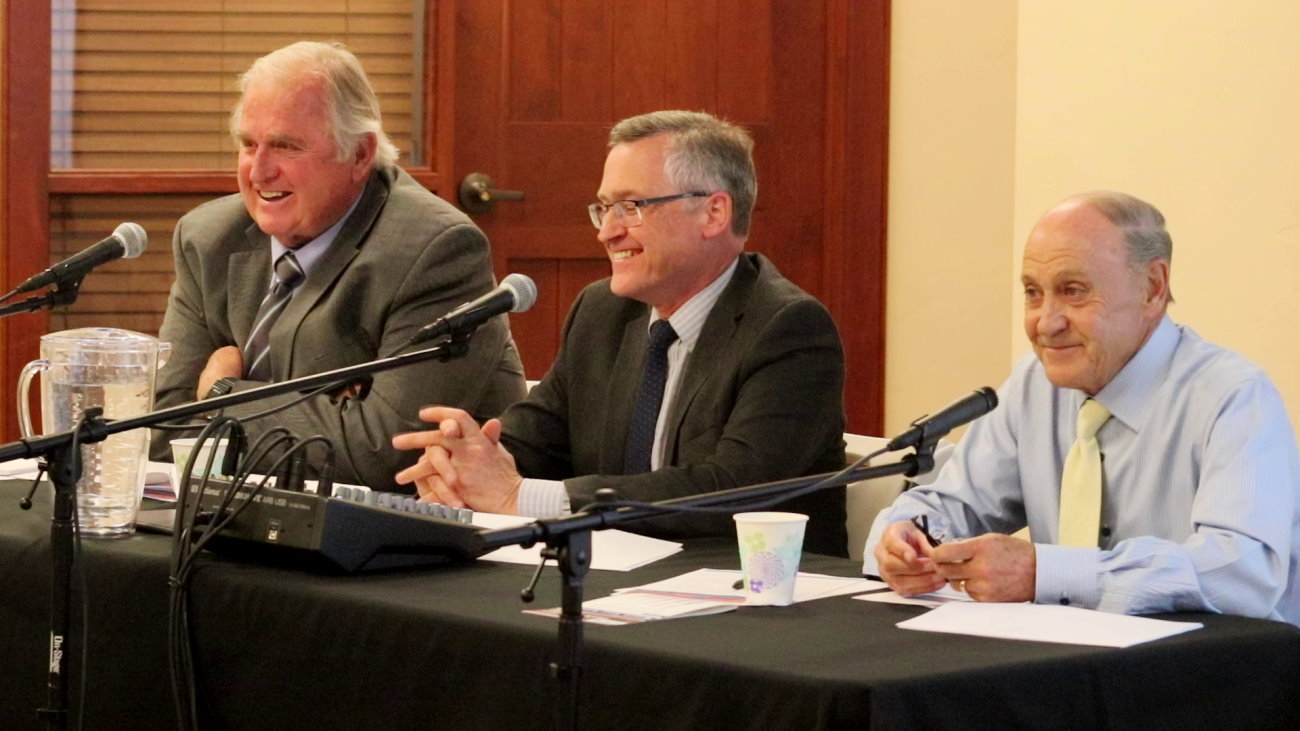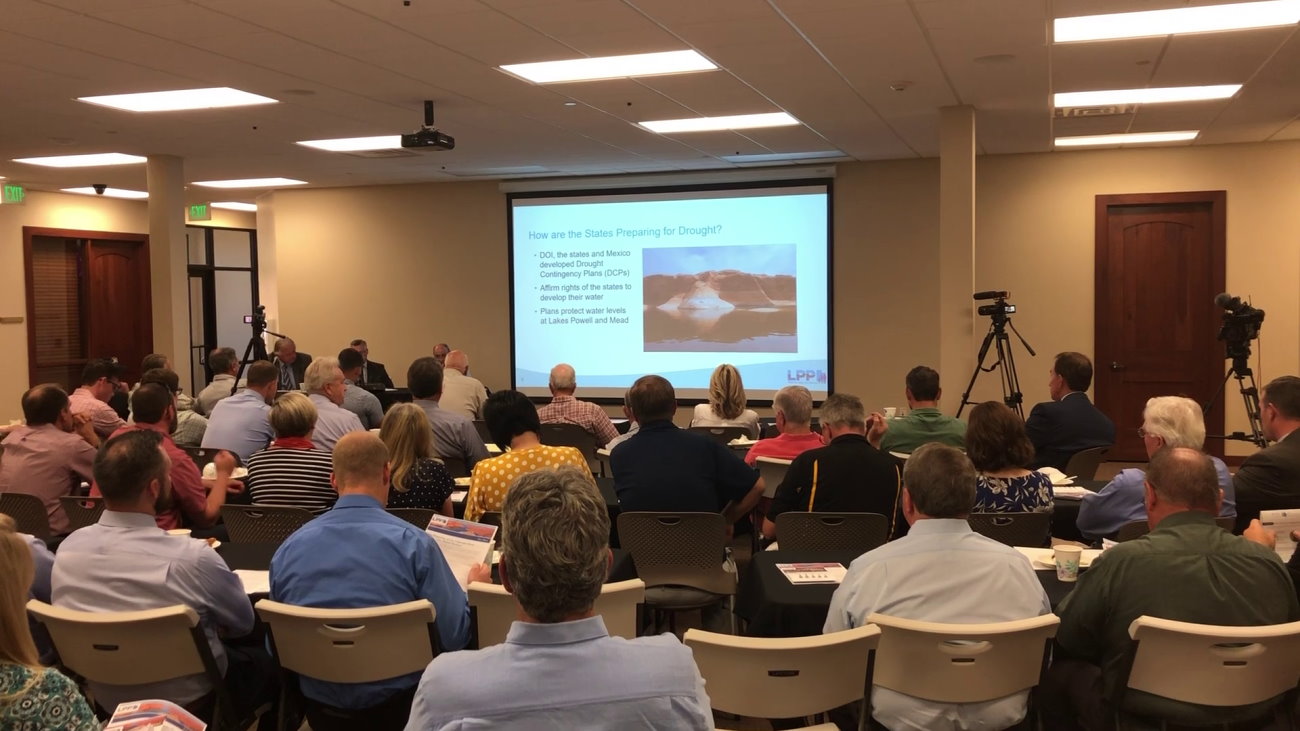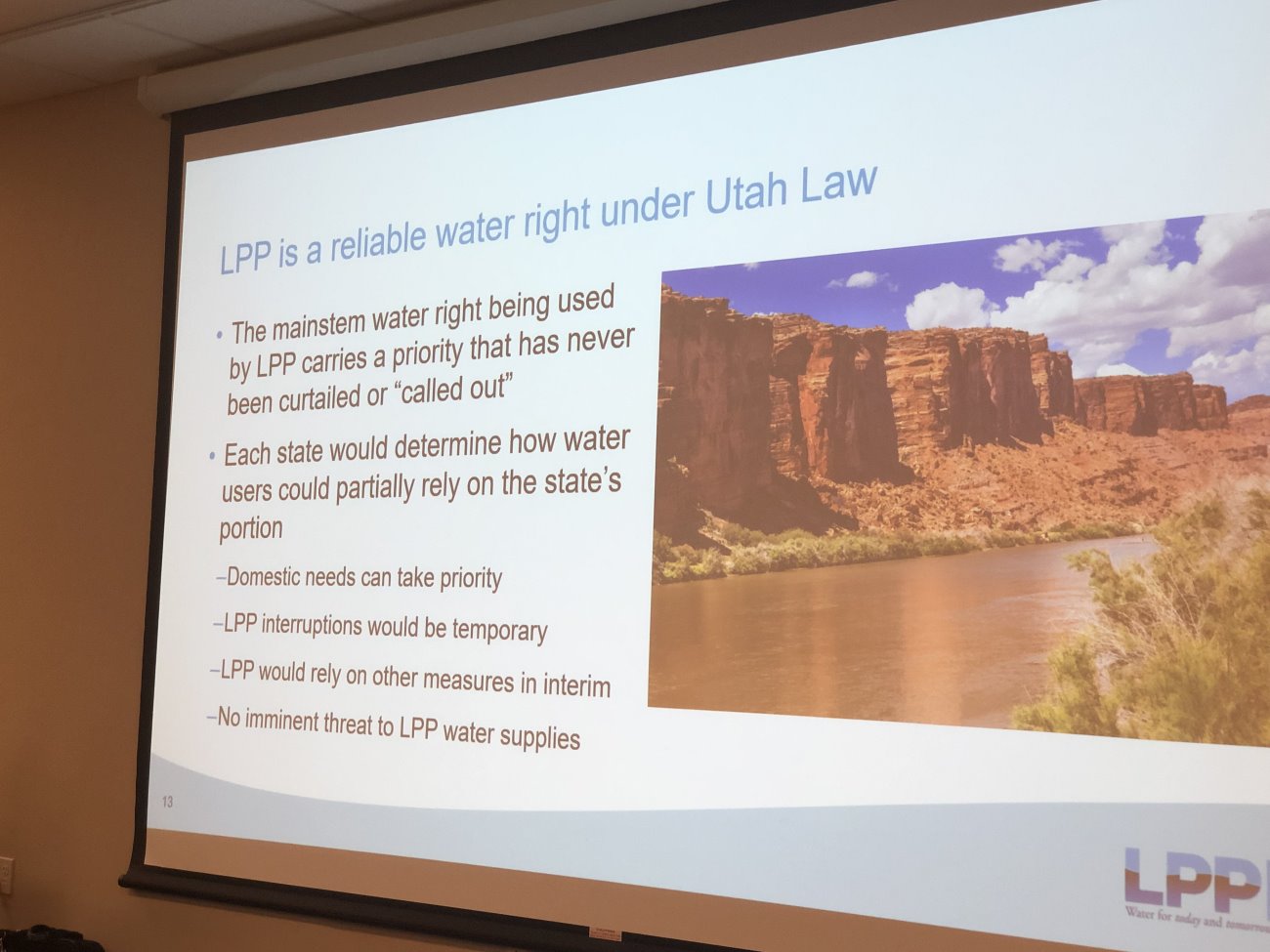ST. GEORGE — The question of whether the Colorado River system is a reliable source of water for the future was the topic of a presentation held at the Washington County Water Conservancy District on Thursday.

Local public and elected officials, past and present, as well as some well-known members of the community gathered at the water district’s office off Red Hills Parkway to hear from three men who claim there’s no need to worry concerning the Colorado River’s ability to deliver water.
“In both wet and dry cycles over the course of a century, the main stem of the Colorado River has always provided enough water to meet established use and (Colorado River) Compact requirements,” said Don Ostler, former executive director and secretary of the Upper Colorado River Commission.
The Colorado River supplies water to 40 million people spread across seven states and parts of Mexico. Those seven states are divided into two parts: the Upper Basin and the Lower Basin. The Upper Basin includes Utah, Colorado, New Mexico and Wyoming, while the Lower Basin includes California, Arizona and Nevada.
Along with Ron Thompson, longtime general manager of the county water district, and Eric Millis, director of the Utah Division of Water Resources, Ostler said recent modeling of projected drought scenarios indicated that “the river should be a reliable supply for the Upper Basin well into the future.”
Thursday’s discussion took more of a big picture approach as to why the Lake Powell Pipeline would be a reliable source water for Kane and Washington counties – because the source it will draw from is the Colorado River, according to the trio of water officials.

According to the 1922 Colorado River Compact, both the Upper and Lower Basin states are promised 7.5 million acre-feet of water a year from the river system.
Utah is entitled to 23%, or about 1.4 million acre feet under the compact. Utah currently uses 1 million acre feet, Millis said. This leave’s the state with 400,000 acre feet to left to develop.
The proposed 140-mile Lake Powell Pipeline would take an estimated 86,000 acre-feet from the Lake Powell to Washington and Kane counties annually.
The amount of water the pipeline would be moving to Kane and Washington County accounts for less than half a percent of the overall capacity of Lake Powell, Millis said.
Opponents of the pipeline project have called the pipeline a diversion from the river that will negatively water users downstream. They also question the legitimacy of the numbers the water district uses to justify the pipeline project.

“There isn’t as much water in the river as they say,” said Nick Schow, conservation director of the Utah River Council. Where pipeline proponents claim there is 15 million acre-feet available annually, that amount is closer to 10 or 12 million based on U.S. Geological Survey data, he said.
Also referencing a report from Brad Udull, a water and climate research scientist at Colorado State University, it is estimated that climate change will cause the river to lose between 20% and 35% of its flow capacity by mid-century.
“The Colorado River is an extremely risky water source,” Schow said.
Projections used by Ostler were a bit more optimistic.
According to a 2012 report cited by Ostler, the Colorado River is estimated to only lose around 9% of its flow capacity over the next 50 years.
Read more: Water district denies that it’s ‘playing fast and loose’ with water supply numbers
More recent hydrology models done by the Bureau of Reclamation also indicates that there is a near 0% chance that future uses of the river system, like the Lake Powell Pipeline, will cause compact requirement shortages, Ostler said.
Even if the hotter, drier climate that’s been experienced over the last 20 years continues, Ostler said there is a possibility for a small percentage of shortages in water supply yet not to the point it wouldn’t be manageable.
Ostler then turned his attention to the Lower Basin states.
“The Lower Basin has great concerns for the dropping in water storage at Lake Mead and the potential there wouldn’t be enough water provided under the compact allocation,” Ostler said as he showed a slide of slightly more water being taken out of Lake Mead than there was coming in.
The Lower Basin had taken 92 million acre-feet of water from the Colorado River over the last 10 years, Ostler said, which is 17 million more than allowed under the compact.
Thompson said the Lower Basin must address its water use.
“They need to find a long term solution,” he said, adding that it was his opinion that if the Lower Basin states didn’t take more water than entitled to, water levels in Lake Powell would be more stable, as it wouldn’t be releasing water to Lake Mead on occasion.

Due to worries over the long-lasting drought and looming impacts of climate change, the states of the Colorado River Compact have drafted drought contingency plans. An overall contingency plan aims to keep to keep Lake Powell and Lake Mead from falling so low they cannot deliver water or produce hydropower. Mexico has also signed onto the plan.
Read more: Trump signs Colorado River drought plan
Part of the plan involves Arizona and Nevada agreeing to reduce their water drawn from Lake Mead. California would be drawn in if the reservoir drops far enough, according to The Associated Press.
The Colorado River Contingency Plan was signed by the participating parties in a ceremony held at Hoover Dam May 20.
“The Lower Basin states are walking away from thousands of acre-feet of water,” Schow said, “and yet here’s Utah, planning on taking water from the river for a county the Utah Rivers Council claims doesn’t even need it.” He also said the Lower Basin states were making great strides in their water conservation efforts.

“They know what’s coming,” he said.
Another issue the Lower Basin faces is the fact it has developed all of its available water resources related to the Colorado River, Ostler said.
Thompson said when people say there’s no water left in the Colorado River, “they’re actually referring to the Lower Basin.”
In contrast, the Upper Basin has developed its water resources at a much slower pace that allows room for projects like the Lake Powell Pipeline to be pursued.
This has been made possible under the Colorado River Compact, Millis said, which doesn’t allow water to be allocated on a “first in time, first in line” basis.
“One of the big questions we get asked in relation to the Lake Powell Pipeline is whether the Colorado River truly is a reliable source of water for the project,” Millis said. “The answer to that is, ‘yes.’”
Email: [email protected]
Twitter: @MoriKessler
Copyright St. George News, SaintGeorgeUtah.com LLC, 2019, all rights reserved.